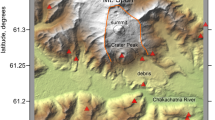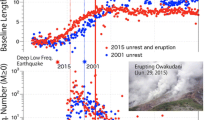Abstract
Campi Flegrei is one of the most densely populated active volcanic areas of the world. It consists of a complex structure with a multicollapse caldera and many postcaldera, explosive, mostly monogenetic vents. The last eruption was in 1538 (Mt. Nuovo). Progressive reduction of eruption energy has accompanied migration of the vents toward the center of the caldera. Campi Flegrei activity is fed by a shallow magma chamber in which trachybasaltic magma undergoes cooling and fractionation, producing trachytic residual melt that is periodically tapped and erupted to the surface. The depth of the chamber is estimated, from petrological and active and passive seismic data, to be about 4 km beneath the town of Pozzuoli. In case of volcanic reactivation, 200 000 people would be at risk and have to be evacuated before its onset. Campi Flegrei caldera has long been the site of slow vertical movements, earthquakes, and thermal activity (hot springs and fumaroles). In the period 1820–1968 the secular trend of ground motion was downward at an average rate of 14 mm/year. In 1968(?)–1972 and in 1982–1984 two episodes of unrest occurred with strong uplift, marked seismicity, increased fumarolic output, and changed thermal-fluid chemistry, well illustrating the complex problems volcanologists face during such volcanic unrest. After both crises, a net uplift remained (150 cm in 1972; 100 cm in 1984), totaling 2.5 m since 1968. Earthquake hypocenters did not exceed 4 km depth, and epicenters were distributed on the inner caldera margins along inward dip** planes. Although neither crisis ended with an eruption, both caused severe civil defense problems and required temporary evacuation of the old center of Pozzuoli. However, in spite of several portending eruption precursors (uplift, seismicity, geochemical anomalies) no alert was issued for an impending eruption, because at the time no clear signs of magma movement toward the surface were recognized. Data processing after the crisis led the majority of geophysicists and geochemists to favor a model in which the unrest was due essentially to heating and thermal expansion of fluid in confined geothermal aquifers, without any direct involvment of the magma chamber. In this paper we present an analysis of data and models showing that overpressure in the Campi Flegrei magma chamber cannot be ruled out and that the two crises could represent two steps in a prolonged process of volcanic reactivation, as probably occurred before the 1538 eruption.
Access this chapter
Tax calculation will be finalised at checkout
Purchases are for personal use only
Preview
Unable to display preview. Download preview PDF.
Similar content being viewed by others
References
Allard P, Maiorani A, Tedesco D, Cortecci G, Turi B (1991). Isotopic study of the origin of sulfur and carbon in Solfatara fumaroles, Campi Flegrei caldera. J Volcanol Geotherm Res 48: 139 – 159
Armienti P, Barberi F, Bizouard H, Clocchiatti R, Innocenti F, Metrich N, Rosi M, Sbrana A (1983). The Phlegraean Fields: magma evolution within a shallow chamber. J Volcanol Geotherm Res 17: 289–311
Armienti P, Barberi F, Innocenti F (1984). A model of the Phlegraean Fields magma chamber in the last 10,500 years. Bull Volcanol 47–2: 349–358
Barberi F, Corrado G, Innocenti F, Luongo G (1984a). Phlegraean Fields 1982–1984: brief chronicle of a volcano emergency in a densely populated area. Bull Volcanol 47–2: 175–185
Barberi F, Hill DP, Innocenti F, Luongo G, Treuil M (eds.) (1984b). The 1982–1984 bradyseismic crisis at Phlegraean Fields (Italy). Bull Volcanol 42–2: 238 pp
Barberi F, Carapezza M, Innocenti F, Luongo G, Santacroce R (1989). The problem of volcanic unrest: the Phlegraean Fields case history. Atti Convegni Lincei 80: 387–405
Barberi F, Cassano E, La Torre P, Sbrana A (1991). Structural evolution of Campi Flegrei calderas in light of volcanological and geophysical data. J Volcanol Geotherm Res 48: 33–49
Berrino G (1994). Gravity changes induced by height-mass variation at the Campi Flegrei caldera. J Volcanol Geotherm Res 61: 293–309
Berrino G, Corrado G, Luongo G, Toro B (1984). Ground deformation and gravity changes accompanying the 1982 Pozzuoli uplift. Bull Volcanol 47–2: 187–200
Berrino G, Corrado G, Lo Bascio A, Luongo G (1986). Deformazioni del suolo ai Campi Flegrei nel periodo 1985–1986. Boll GNV 3: 73–79
Bianchi R, Corradini A, Federico C, Giberti G, Sartoris G, Scandone R (1984). Modelling of surface ground deformations in the Phlegraean Fields volcanic area, Italy. Bull Volcanol 47–2: 321–330
Bonafede M (1990). Axy-symmetric deformation of a thermo-poro-elastic half space: inflation of a magma chamber. Geophys J Int 103: 289–299
Bonafede M (1991). Hot fluid migration: an efficient source of ground deformation: application to the 1982–1985 crisis at Campi Flegrei, Italy. J Volcanol Geotherm Res 48: 187–198
Capocci E (1835). Nuove ricerche sul noto fenomeno delie colonne perforate dalle poladi nel tempio di Serapide in Pozzuoli. Il progresso delle Scienze, Lettere delle Arti 11: 66–76
Carapezza M, Nuccio PM, Valenza M (1984). Geochemical surveillance at the Solfatara of Pozzuoli during 1983. Bull Volcanol 47–2: 303–311
Casertano L, Oliveri del Castillo A, Quagliariello MT (1976). Hydrodynamics and geodynamics in Campi Flegrei area of Italy. Nature 264: 5582
Chelini W, Sbrana A (1987). Subsurface geology Chapt 7. In: Phlegraean Fields. Quad Ric Sci 114 – 9: 94–103
Cioni R, Corazza E, Marini L (1984). The gas/steam ratio as indicator of heat transfer at the Solfatara fumaroles, Phlegraean Fields (Italy). Boll Volcanol 47–2: 295–302
Cioni R, Corazza E, Fratta M, Guidi M, Magro G, Marini L (1989). Geochemical precursors at Solfatara volcano, Pozzuoli (Italy). In: Latter JW (ed) Volcanic Hazards. Springer, Berlin Heidelberg New York 625 pp
Corrado G, Guerra I, Lo Bascio A, Luongo G, Rampoldi F (1976). Inflation and microearthquake activity of Phlegraean Fields, Italy. Bull Volcanol 40: 169–188
De Natale G, **ue F (1993). Ground deformations in collapsed caldera structures. J. Volcanol Geotherm Res 57: 19–38
De Natale G, Zollo A (1986). Statistical analysis and clustering features of the Phlegraean Fields earthquake sequence (May 1983-May 1984). Bull Seismol Soc Am 76: 801–814
De Natale G, **ue F, Allard P, Zollo A (1991). Geophysical and geochemical modeling of the 1982–1984 unrest phenomena at Campi Flegrei caldera (Southern Italy). J Volcanol Geotherm Res 48: 199–222
De Natale G, **ue F, Mastrolorenzo G (1993). Modelli vulcanologici del bradisismo flegreo. Boll GNGTS 507–520
Dvorak J, Gasparini P (1991). History of earthquakes and vertical ground movement in Campi Flegrei caldera, Southern Italy: comparison of precursory events to the A.D. 1538 eruption of Monte Nuovo and of activity since 1968. J Volcanol Geotherm Res 48: 77–92
Ferrucci F, Hirn A, De Natale G, Virieux J, Mirabile L (1992). P-SV conversions at a shallow boundary beneath Campi Flegrei caldera (Italy): evidence for the magma chamber. J Geophys Res 97-B11: 15351–15359
Hill DP (1984). Monitoring unrest in a large silicic caldera, the Long Valley-Inyo craters volcanic complex in East-Central California. Bull Volcanol 47–2: 371–396
Italiano F, Nuccio PM, Valenza M (1984). Geothermal energy release at the Solfatara of Pozzuoli (Phlegraean Fields): phreatic and phreatomagmatic explosion risk implications. Bull Volcanol 47–2: 275–285
Klein FW (1982). Patterns of historical eruption at Hawaiian volcanoes. J Volcanol Geotherm Res 12: 1–35
Luongo G, Scandone R (eds) (1991). Campi Flegrei. J Volcanol Geotherm Res Special Issue, 44: 227
Martini M (1989). The forecasting significance of chemical indicators in areas of quiescent volcanism: examples from Vulcano and Phlegraean Fields (Italy). In: Latter (ed.) J.H. Volcanic Hazards. Springer, Berlin Heidelberg New York 625 pp
Martini M, Cellini Legittimo P, Piccdardi G, Giannini L (1984). Composition of hydrothermal fluids during the bradyseismic crisis, which commenced at Phlegraean Fields in 1982. Bull Volcanol 47–2: 267–274
Martini M, Giannini L, Buccianti A, Prati F, Cellini Legittimo P, Iozzelli P, Capaccioni B (1991). 1980–1990: ten years of geochemical investigation at Phlegraean Fields (Italy). J Volcanol Geotherm.Res 48: 161–411
Mc Kee CO, Lowenstein PL, De Saint Ours P, Talai B, Itikarai I, Mori JJ (1984). Seismic and ground deformation crises at Rabaul caldera: prelude to an eruption?. Bull Volcanol 47–2: 397–411
Parascandola A (1946). Il Monte Nuovo e Il Lago Lucrino. Boll Soc Nat Napoli 60: 314 pp
Penta F (1955). Caratteristiche e genesi delle manifestazioni esalativo-idrotermali naturali. Atti XLV riunione Soc Ital Prog Sci Napoli. Editrice Italia Roma 1–31
Rosi M, Santacroce R (1984). Volcanic hazard assessment in the Phlegraean Fields: a contribution based on stratigraphic and historical data. Bull Volcanol 47–2: 359–370
Rosi M, Sbrana A (eds) (1987). Phlegraean Fields. Quad Ric Sci 114–9: 175 pp
Rosi M, Sbrana A, Principe C (1983). The Phlegraean Fields structural evolution, volcanic history and eruptive mechanism. J Volcanol Geotherm Res 17: 273–288
Scandone R, Bellucci F, Lirer L, Rolandi G (1991). The structure of the Campanian Plain and the activity of Napolitan volcanoes (Italy). J Volcanol Geotherm Res 48: 1–31
Tedesco D, Allard P, Sano Y, Wakita H, Pece R (1990). Helium-3 in subaerial and submarine fumaroles of Campi Flegrei caldera, Italy. Geochim Cosmochim Acta 54: 1105–1116
Vilardo G. , Alessio G, Luongo G (1991). Analysis of the magnitude-frequency distribution for the 1983–1984 earthquake activity of Campi Flegrei, Italy. J Volcanol. Geotherm Res 48: 115–125
Author information
Authors and Affiliations
Rights and permissions
Copyright information
© 1996 Springer-Verlag Berlin Heidelberg
About this chapter
Cite this chapter
Barberi, F., Carapezza, M.L. (1996). The Problem of Volcanic Unrest: The Campi Flegrei Case History. In: Monitoring and Mitigation of Volcano Hazards. Springer, Berlin, Heidelberg. https://doi.org/10.1007/978-3-642-80087-0_23
Download citation
DOI: https://doi.org/10.1007/978-3-642-80087-0_23
Publisher Name: Springer, Berlin, Heidelberg
Print ISBN: 978-3-642-80089-4
Online ISBN: 978-3-642-80087-0
eBook Packages: Springer Book Archive




